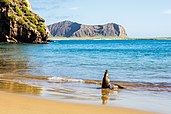Portal:Ecuador/Selected article
| This page is currently inactive and is retained for historical reference. Either the page is no longer relevant or consensus on its purpose has become unclear. To revive discussion, seek broader input via a forum such as the village pump. |
The Galápagos Islands (Spanish: Islas Galápagos) are an archipelago of volcanic islands in the Eastern Pacific, located around the Equator 900 km (560 mi) west of the mainland of South America. They form the Galápagos Province of the Republic of Ecuador, with a population of slightly over 33,000 (2020). The province is divided into the cantons of San Cristóbal, Santa Cruz, and Isabela, the three most populated islands in the chain. The Galápagos are famous for their large number of endemic species, which were studied by Charles Darwin in the 1830s and inspired his theory of evolution by means of natural selection. All of these islands are protected as part of Ecuador's Galápagos National Park and Marine Reserve.
Thus far, there is no firm evidence that Polynesians or the indigenous peoples of South America reached the islands before their accidental discovery by Bishop Tomás de Berlanga in 1535. If some visitors did arrive, poor access to fresh water on the islands seems to have limited settlement. The Spanish Empire similarly ignored the islands, although during the Golden Age of Piracy various pirates used the Galápagos as a base for raiding Spanish shipping along the Peruvian coast. The goats and black and brown rats introduced during this period greatly damaged the existing ecosystems of several islands. British sailors were chiefly responsible for exploring and mapping the area. Darwin's voyage on HMS Beagle was part of an extensive British survey of the coasts of South America. Ecuador, which won its independence from Spain in 1822 and left Gran Colombia in 1830, formally occupied and claimed the islands on 12 February 1832 while the voyage was ongoing. José de Villamil, the founder of the Ecuadorian Navy, led the push to colonize and settle the islands, gradually supplanting the English names of the major islands with Spanish ones. The United States built the islands' first airport as a base to protect the western approaches of the Panama Canal in the 1930s. After World War II, its facilities were transferred to Ecuador. With the growing importance of ecotourism to the local economy, the airport modernized in the 2010s, using recycled materials for any expansion and shifting entirely to renewable energy sources to handle its roughly 300,000 visitors each year. (Full article...) (Full article...)

